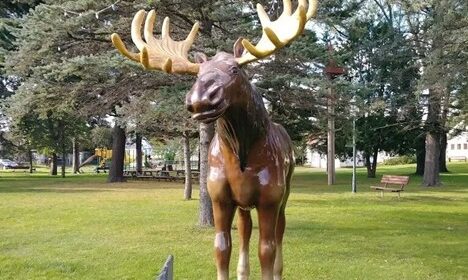Guest Blog: Bog Biodiversity
Editor’s Note: Clinton Nienhaus is a naturalist at Sax-Zim Bog. His occasional guest blogs share information about the bog and its’ inhabitants, as well as activities taking place there throughout the year.
As I illuded to in the last blog post, the Sax-Zim Bog is incredibly diverse in habitat types, as well as diverse in the opportunities to learn a little more about these habitats and species that call them home. From my perspective, as Head Naturalist for the Friends of Sax-Zim Bog, birds are the big draw for folks during most of the year, but those same folks are missing so much when they visit! Hopefully, this post will give some perspective on what can be found when exploring the Sax-Zim Bog, looking for birds or other species.
First, let’s talk birds! The Sax-Zim Bog is home to a host of boreal forest specialists, and those species that can be hard to find in other places. Each year, during the winter, we see an average of 2600 visitors, from 30+ states and at least 2 or 3 different countries. In the summer, there are fewer visitors, but that doesn’t mean the birds are gone! Sax-Zim Bog’s bird list is over 240 species, with many of those species staying to nest. The top bird species most folks are coming to the Sax-Zim Bog to see include Great Gray Owl, Connecticut Warbler, Black-backed Woodpecker, Golden-winged Warbler, LeConte’s Sparrow, Sedge Wren, among others. In the winter, most visitors want to see owls, including Great Gray Owl, Northern Hawk Owl, winter finches such as Common and Hoary Redpoll, Pine Grosbeak, Evening Grosbeak, as well as Boreal Chickadee, Gray Jay, and Sharp-tailed Grouse. For summer, Yellow-bellied, Alder, and Olive-sided Flycatcher, 19 species of warbler, Lincoln’s Sparrow, Winter Wren, and even Pileated Woodpecker top most visitor’s lists.
The Sax-Zim Bog may be a haven for boreal bird species, but there is much more than the diversity of resident bird species or winter visitors. Birds make up a small portion of the over 1,275 species that have been documented (so far!) in the Sax-Zim Bog. This huge diversity can be observed by traversing the 423 acres of land owned by the Friends of Sax-Zim Bog, by investigating the roadsides that meander through the Bog, or in the rivers, streams, and lakes in the Sax-Zim Bog Important Bird Area. With 147,000 acres to cover, 1,275+ species is a great number, but there are more species to be found!
If we look close at the numbers, insects make up over a third of the species observed. This is not very surprising, as insects tend to make up most of the diversity in any given location. 415 species of insect have been found in the Sax-Zim Bog, but with 147,000 acres larger underexplored for insect diversity, this number could be two to three times as high! There is a lot of work to be done to find and identify the insects in the Sax-Zim Bog, but there are folks interested in the butterflies, dragonflies and damselflies, tiger beetles, bumblebees, ladybugs of the Sax-Zim Bog who document their finds during their visits. The work of volunteers or excited visitors really helps bolster our understanding of this amazing place! Some insects of interest include 76 species of dragonfly and damselfly, 64 species of butterfly, and over 100 species of moth documented so far.
When you think of northern Minnesota, or bogs, you probably don’t think of the butterflies or other insects you can find; you probably think of the trees and the plants you find during your time in the Northwoods. Well, plants account for over 400 species of the 1,275 documented so far. This includes 93 species of sedge and grass, 14 species of orchid, pitcher plants, round-leaved sundew, and 46 species of tree make the Sax-Zim Bog a place worth a visit by casual wildflower watcher to botanists. Each of these plants play a big role into the diversity of birds that can be found in the Sax-Zim Bog.
Numbers of species are all good and fine, but what is so important about preserving biodiversity? Biodiversity really translates well as a mark on the health of an ecosystem. The more species you can find, the higher quality an ecosystem. The healthier the ecosystem, the better off the animals and folks like you and I are able to enjoy what can be found on a short stroll in the woods. Consider the number of species found in the Sax-Zim Bog: 1,275. Ecologically, you can start to develop a bigger picture of an area: 1,275 means that there is a diverse set of organisms in this place that have been able to survive due high quality ecosystems in the Sax-Zim Bog. 1,275 means that there is an ecosystem that is worth investigating and exploring in person and through preservation those same 1,275 (and more) can be seen by future generations! Bird and Wildlife watching are among the fastest growing outdoor recreation activities in the United States and the diversity in the Sax-Zim Bog attracts bird watchers, butterfly watchers, wildflower lovers, and even dragonfly and damselfly enthusiasts.
An easy way to enjoy and learn more about the Sax-Zim Bog would be to attend one or more of the education programs offered during the spring, summer, and winter months. This summer will have programs featuring fern identification, lichen identification, bird watching trips, dragonfly and damselfly programs, and even a program on spiders! Another great way to experience the Sax-Zim Bog is to attend our BioBlitz, currently scheduled for July 7th. This will be our 6th annual BioBlitz, where experts go out into the field with trip participants to showcase and find new species in the Sax-Zim Bog! It is a great way to learn about wildflowers, spiders, butterflies, or even fish and aquatic plants! Typically 40 folks attend this one day event and it is always and exciting time for leaders and participants both. To find out more about our field trips, education programs, or the BioBlitz check out our website by following this link: http://saxzim.org/events/. If you have any particular questions about a species of interest or want to register for a program, email Head Naturalist Clinton at naturalist@saxzim.org. And be sure to check out the Bog Blog for articles about biodiversity in the Sax-Zim Bog, or any other of our upcoming and past projects by following this link: http://saxzim.org/sax-zim-bog-news/.
The Sax-Zim Bog is an amazing place and the spring season is upon! Time to get out and enjoy the plants and flowers, sounds and smells, of Spring in the Sax-Zim Bog!
Until then, we will see you in the Bog!
–Clinton Nienhaus, Friends of Sax-Zim Bog Head Naturalist.




